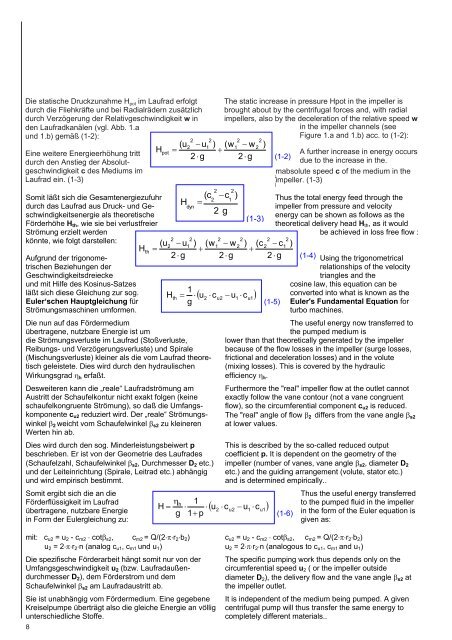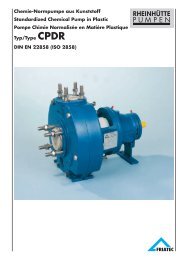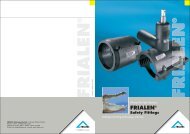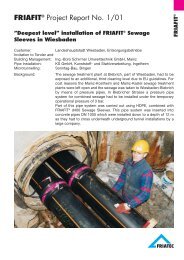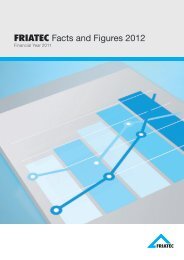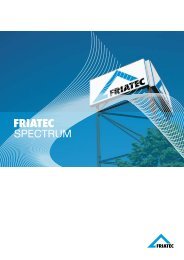Kreiselpumpen Technische Auslegung Centrifugal Pumps ... - Friatec
Kreiselpumpen Technische Auslegung Centrifugal Pumps ... - Friatec
Kreiselpumpen Technische Auslegung Centrifugal Pumps ... - Friatec
Sie wollen auch ein ePaper? Erhöhen Sie die Reichweite Ihrer Titel.
YUMPU macht aus Druck-PDFs automatisch weboptimierte ePaper, die Google liebt.
Die statische Druckzunahme Druckzunahme im Laufrad Hpot erfolgt im Laufrad durch die erfolgt Flieh-<br />
durch kräfte die und Fliehkräfte bei Radialrädern und bei zusätzlich Radialrädern durch zusätzlich Verzöge-<br />
The static increase in pressure Hpot in the impeller is<br />
brought The increase about in by pressure the centrifugal in the impeller forces and, is brought with radial about<br />
durch Verzögerung der Relativgeschwindigkeit w in impellers, by the centrifugal also by forces the deceleration and, with radial of the impellers, relative speed also w<br />
den rung Laufradkanälen der Relativgeschwindig- (vgl. Abb. 1.a<br />
in by the the impeller deceleration channels of the (see relative<br />
und keit w 1.b) in gemäß den Laufradkanälen<br />
(1-2):<br />
Figure speed 1.a w in and the 1.b) impeller acc. channels to (1-2):<br />
2 2<br />
2 2<br />
(vgl. Abb. 1.a und 1.b) mit:<br />
( u2<br />
� u1<br />
) ( w1<br />
� w 2 ) (see Figure 1.a and 1.b) with:<br />
Eine weitere Energieerhöhung tritt<br />
Hpot<br />
� �<br />
A further increase in energy occurs<br />
Eine weitere Energieerhöhung tritt<br />
2 � g 2 � g (1-2)<br />
durch den Anstieg der Absolut-<br />
due A further to the increase in in energy the.<br />
geschwindigkeit<br />
durch den Anstieg<br />
c des<br />
der Absolut-<br />
Mediums im<br />
occurs due to the increase in the.<br />
mabsolute speed c of the medium in the<br />
Laufrad<br />
geschwindigkeit<br />
ein. (1-3)<br />
c des Mediums im<br />
absolute speed c of the medium in the<br />
impeller. (1-3)<br />
Laufrad ein.<br />
impeller.<br />
Somit läßt sich die Gesamtenergiezufuhr<br />
durch das Laufrad aus Druck- und Geschwindigkeitsenergie<br />
als theoretische<br />
Förderhöhe Hth, wie sie bei verlustfreier<br />
Strömung erzielt werden<br />
2 2<br />
( c �c<br />
)<br />
2 1<br />
H �<br />
dyn<br />
2 g<br />
(1-3)<br />
Thus the total energy feed through the<br />
impeller from pressure and velocity<br />
energy can be shown as follows as the<br />
theoretical delivery head Hth, as it would<br />
be achieved in loss free flow :<br />
könnte, wie folgt darstellen:<br />
Aufgrund der trigonome-<br />
2 2<br />
2 2 2 2<br />
( u2<br />
� u1<br />
) ( w1<br />
� w 2 ) ( c 2 � c1<br />
)<br />
Hth<br />
� �<br />
�<br />
2 � g 2 � g 2 � g (1-4) Using the trigonometrical<br />
trischen Beziehungen der<br />
relationships of the velocity<br />
Geschwindigkeitsdreiecke<br />
triangles and the<br />
und mit Hilfe des Kosinus-Satzes<br />
läßt sich diese Gleichung zur sog.<br />
Euler‘schen Hauptgleichung für<br />
1<br />
Hth � � �u2�cu2�u1�cu1� g<br />
(1-5)<br />
cosine law, this equation can be<br />
converted into what is known as the<br />
Euler's Fundamental Equation for<br />
Strömungsmaschinen umformen.<br />
turbo machines.<br />
Die nun auf das Fördermedium<br />
The useful energy now transferred to<br />
übertragene, nutzbare Energie ist um<br />
the pumped medium is<br />
die Strömungsverluste im Laufrad (Stoßverluste,<br />
lower than that theoretically generated by the impeller<br />
Reibungs- und Verzögerungsverluste) und Spirale because of the flow losses in the impeller (surge losses,<br />
(Mischungsverluste) kleiner als die vom Laufrad theore- frictional and deceleration losses) and in the volute<br />
tisch geleistete. Dies wird durch den hydraulischen (mixing losses). This is covered by the hydraulic<br />
Wirkungsgrad �h erfaßt.<br />
efficiency �h.<br />
Desweiteren kann die „reale“ Laufradströmung am<br />
Austritt der Schaufelkontur nicht exakt folgen (keine<br />
schaufelkongruente Strömung), so daß die Umfangskomponente<br />
cu2 reduziert wird. Der „reale“ Strömungswinkel<br />
�2 weicht vom Schaufelwinkel �s2 zu kleineren<br />
Werten hin ab.<br />
Dies wird durch den sog. Minderleistungsbeiwert p<br />
beschrieben. Er ist von der Geometrie des Laufrades<br />
(Schaufelzahl, Schaufelwinkel �s2, Durchmesser D2 etc.)<br />
und der Leiteinrichtung (Spirale, Leitrad etc.) abhängig<br />
und wird empirisch bestimmt.<br />
Somit ergibt sich die an die<br />
Förderflüssigkeit im Laufrad<br />
übertragene, nutzbare Energie<br />
in Form der Eulergleichung zu:<br />
mit: cu2 = u2 - cm2 � cot�s2, cm2 = Q/(2���r2�b2)<br />
u2 = 2���r2�n (analog cu1, cm1 und u1)<br />
Die spezifische Förderarbeit hängt somit nur von der<br />
Umfangsgeschwindigkeit u2 (bzw. Laufradaußendurchmesser<br />
D2), dem Förderstrom und dem<br />
Schaufelwinkel �s2 am Laufradaustritt ab.<br />
8<br />
� 1<br />
H �<br />
�<br />
g 1�<br />
p<br />
Sie ist unabhängig vom Fördermedium. Eine gegebene<br />
Kreiselpumpe überträgt also die gleiche Energie an völlig<br />
unterschiedliche Stoffe.<br />
Furthermore the "real" impeller flow at the outlet cannot<br />
exactly follow the vane contour (not a vane congruent<br />
flow), so the circumferential component cu2 is reduced.<br />
The "real" angle of flow �2 differs from the vane angle �s2<br />
at lower values.<br />
This is described by the so-called reduced output<br />
coefficient p. It is dependent on the geometry of the<br />
impeller (number of vanes, vane angle �s2, diameter D2<br />
etc.) and the guiding arrangement (volute, stator etc.)<br />
and is determined empirically..<br />
�u�c�u� h � � 2 u2<br />
1 cu1<br />
(1-6)<br />
Thus the useful energy transferred<br />
to the pumped fluid in the impeller<br />
in the form of the Euler equation is<br />
given as:<br />
cu2 = u2 - cm2 � cot�s2, cm2 = Q/(2���r2�b2)<br />
u2 = 2���r2�n (analogous to cu1, cm1 and u1)<br />
The specific pumping work thus depends only on the<br />
circumferential speed u2 ( or the impeller outside<br />
diameter D2), the delivery flow and the vane angle �s2 at<br />
the impeller outlet.<br />
It is independent of the medium being pumped. A given<br />
centrifugal pump will thus transfer the same energy to<br />
completely different materials..


